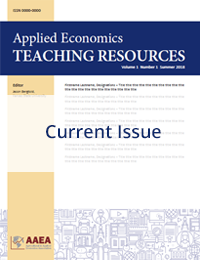Teaching Education Commentary
A Commentary on Extension Programming: An Overview of the Costs and Benefits of Patch-Burn Grazing Extension Program Development Through the Use of a Logic Model
Hannah M. Baker(a) and Hannah E. Shear(b)
(a)University of Florida, (b)Oklahoma State University
JEL Codes: JEL Codes: A10, Q15
Keywords: Cattle, Extension program development, graduate student, logic model, patch-burn grazing, rangeland management
Publish Date: May 22, 2024
Abstract
The Extension program discussed in this commentary was developed using a logic model to provide the missing economic analysis of patch-burn grazing in comparison to traditional rangeland management practices. It was submitted to the Graduate Student Extension Competition through the Agricultural and Applied Economics Association (AAEA) to take advantage of the opportunity to present patch-burn grazing as a potential cost-reducing and beneficial management practice to Oklahoma cow-calf producers. Delivery plans and communication methods for the program include fact sheets and budget tools, research articles, conference presentations, and workshops. The development of this Extension program centered around the economics of patch-burn grazing is supplemental to ongoing research by the Prairie Project. The Prairie Project utilizes outputs such as fact sheets, workshops, and social media to convey the benefits of patch-burn grazing, which has been shown to be effective. The opportunity to build an Extension program around research using a logic model allows young professionals to learn how to build a successful program.
References
Adhikari, S., O. Joshi, M.G. Sorice, and S.D. Fuhlendorf. 2023. “Factors Affecting the Adoption of Patch-Burn Grazing in the Southern Great Plains in the U.S.” Land Use Policy 125:106458.
Israel, G.D. 2001. “Using Logic Models for Program Development.” Gainesville: University of Florida Institute of Food and Agricultural Sciences. https://edis.ifas.ufl.edu/publication/WC041
Israel, G.D. 2021. “Logic Model Basics.” Gainesville: University of Florida Institute of Food and Agricultural Sciences. https://edis.ifas.ufl.edu/publication/WC106
Limb, R.F., S.D. Fuhlendorf, D.M. Engle, J.R. Weir, R.D. Elmore, and T.G. Bidwell. 2011. “Pyric–Herbivory and Cattle Performance in Grassland Ecosystems.” Rangeland Ecology & Management 64(6):659–663.
Smith, S. 2011. “Eastern Red-Cedar: Positives, Negatives and Management.” Ardmore OK: The Samuel Roberts Noble Foundation, pp. 1–8.
Twidwell, D., C.H. Bielski, R. Scholtz, and S.D. Fuhlendorf. 2021. “Advancing Fire Ecology in 21st Century Rangelands.” Rangeland Ecology & Management 78:201–212.
Articles in this issue
Promoting Sustainable Products in Dry Consumer Packaged Goods: What Should a Grocer Do?
Michael A. Boland, Xiaowei Zhang
Renaissance Ag: Identifying the Who, How, and Where of Marketing a New Technology
Chanden Westover and Tanner McCarty
A Commentary on Extension Programming: An Overview of the Costs and Benefits of Patch-Burn Grazing Extension Program Development Through the Use of a Logic Model
Hannah M. Baker and Hannah E. Shear
Applied Economic Models of Commodity and Input Markets to Assess Prices, Quantities, Farm and Other Input Supplier Impacts, and Consumer and Taxpayer Costs
Joe Dewbre, Wyatt Thompson, Sera Chiuchiarelli
Risk Management Education for Executives in the Food and Agriculture Industry
Emily Garwood and Brian K. Coffey
Teaching The Economics of Corporate Social Responsibility: A Mixed Motive Bargaining Simulation Game
Anukul Bhattari and George C. Davis
Demand Dashboards: Interactive Tools to Communicate Consumer Behavior
Justin D. Bina and Glynn T. Tonsor
Engaging Undergraduate Students in Research: From Cross-Discipline Programs to Published Articles
Gal Hochman and Yanhong Jin


